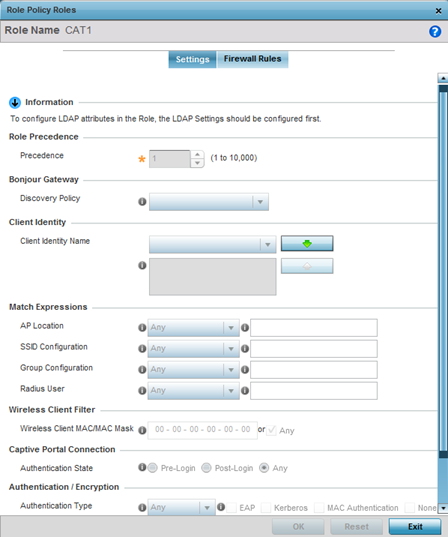To add a new wireless client role policy:

Bonjour provides a method to discover services on a LAN. Bonjour allows users to set up a network without any configuration. Services such as printers, scanners and file-sharing servers can be found using Bonjour. Bonjour only works within a single broadcast domain. However, with a special DNS configuration, it can be extended to find services across broadcast domains.

Note
The WiNG 7.1 release does not provide support for Bonjour feature on AP505 and AP510 model access points. This feature will be supported in future releases.| AP Location | Use the drop-down menu to specify the location of an
access point matched in an RF domain or the access point‘s
resident configuration. Select one of the following filter
options:
|
| SSID Configuration | Use the drop-down menu to define a wireless client filter
option based on how the SSID is specified in a WLAN. Select
one of the following options:
|
| Group Configuration | Use the drop-down menu to define a wireless client filter
option based on how the RADIUS group name matches the
provided expression. Select one of the following options:
|
| RADIUS User | Use the drop-down menu to define a filter option based on
how the RADIUS user name (1-255 characters in length)
matches the provided expression. Select one of the following
options:
|
| Equals | The role is applied only when the authentication and encryption type matches the exact method(s) specified by the radio button selections. |
| Not Equals | The role is applied only when the authentication and encryption type does not match the exact method(s) specified by the radio button selections. |
| Any | The role is applied to any type. This is the default setting for both authentication and encryption. |
| Exact | The role is applied only when the exact string is specified in the role. |
| Contains | The role is applied when the LDAP attribute contains the string specified in the role. |
| Does Not Contain | The role is applied when the LDAP attribute does not contain the string specified in the role. |
| Any | The role is applied to any LDAP attribute. This is the default setting. |
| City | Enter a 2-31 character name of the city filtered in the role. |
| Company | Enter a 2-31 character name of the organizational company filtered in the role. |
| Country | Enter a 2-31 character name of the country (co) filtered in the role. |
| Department | Enter a 2-31 character name of the organizational department filtered in the role. |
| Enter a 2-31 character name of the Email address filtered in the role. | |
| Employee Id | Enter a 2-31 character name of the employee ID filtered in the role. |
| State | Enter a 2-31 character name of the state filtered in the role. |
| Title | Enter a 2-31 character name of the job or organizational title filtered in the role. |
| Member Of | Provide a 64 character maximum description of the group membership in the role. |